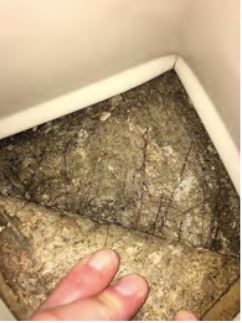
Lawmakers find systemic issues as military families suffer in on-base housing
Some privatized military housing is rat infested and full of mold. DoD and management companies had few answers as to how it got so bad.
After testimony from military families depicting black mold, rats, faulty wiring and other substandard living conditions in their privatized on-base housing, the Defense Department and housing management companies had little more than apologies and promises to offer during a Senate Armed Services hearing yesterday.
At the end of a more than three hour hearing, DoD and companies like Balfour Beatty Communities, Corvias Group and Hunt Military Communities — which build and manage privatized, on-base military housing — had few answers for the nearly 1,100 children living in military housing presenting high lead levels in their blood, families sickened by mold in their homes or service members with toxic chemicals in the air and soil of their living areas. Some of the issues have yet to be remediated by DoD or the management companies.
“I’m infuriated by what I’m hearing today. This is disgusting,” said Sen. Martha McSally (R-Ariz.), who is an Air Force veteran. “There are people I hope look themselves in the mirror tonight. Instead of being partners with our troops, to make sure our way of life is kept safe and free, they left military families hanging. They put you in harm’s way. This is so wrong and so angering to many of us.”
The hearing comes directly on the heels of a Military Family Advisory Network survey, which found 55.53 percent of the nearly 17,000 respondents had a negative or very negative experience with privatized military housing. Only about 16 percent responded that they had a positive experience.
The survey found the issues were spread out over more than thirty companies and respondents stated their reports for remediation were often denied or ignored.
“I felt ill every time I was in the house,” Rachel Christian, a military spouse at Ft. Polk, Louisiana, said in the survey. “The heat wasn’t working correctly, the HVAC wasn’t working, we had a leaking roof that Corvias would patch over part of in the kitchen, but we never found where the leak was coming from.”
According to the survey, when the Christians found mold, they were told by Corvias to “’spray some bleach and we will come paint.” Their son was vomiting continuously and lead was found in his blood. Their water tested positive for lead.
The management company representatives said they are tapping into hundreds of millions of dollars for the maintenance and repair of homes, as well as changing their policies for mold and mildew.
“We are at, what I would call, a critical inflection point in where our program is and we know we need to get to the bottom of the challenges that we are facing,” said John Picerne, founder and CEO of the Corvias Group. “We have some new homes and we have some older homes that need major renovations. We’ve had some challenges in dealing with that.”
Picerne said his company will support the aggrieved families and any others going forward in improving conditions.
Despite the extra funds and policy changes, lawmakers said there was a larger issue at hand.
“The system is broken,” Senate Armed Services Ranking Member Jack Reed (D-R.I.) said. “These problems were obvious to the military families, but they were not obvious enough to you to take effective corrective action. We have to think collectively, working with the Department of Defense and the service departments, to come up with appropriate incentives and disincentives, so once again you don’t take your eye off the target.”
All five of the companies testifying before the committee agreed that communication between the residents, the companies and the command needed to be improved.
Lawmakers also wondered how things got so bad, and why DoD did not step in sooner.
“This is a failure of leadership on both sides,” said Robert McMahon, DoD assistant secretary of defense for sustainment.
Sen. Elizabeth Warren (D-Mass.) said incentive fees based on performance were delivered 95 percent of the time to the management companies.
“How is it that these guys can get 95 percent of their incentive fees, plus their base fee, plus their expenses at the same time we are hearing this kind of testimony from military families?” Warren said.
DoD does an annual survey on military housing to get a picture of the conditions and leaves inspections to the individual services, but its response rate ranges from 35 to 50 percent.
Alex Beehler, assistant secretary of the Army for installations, energy and environment, said his service inspected all of the privatized homes in the past year.
“What we found, we took and made repairs and instigated work orders,” Beehler said.
Warren responded, “OK, you inspected, but you didn’t see the rats? I just don’t understand what that means. This just isn’t right. These contracts are bad enough as they are because they are virtually guaranteed profit in return for which they are supposed to provide decent housing. The one tool you’ve got is to say there’s got to be some performance evaluation here. To give away 95 percent of the performance-based money, and at same time, we are hearing from the people who live in this housing that it’s rat infested, that it’s dirty, that things leak, that’s just not right. You’re not using the tools Congress gave to you on behalf of our service members.”
Christopher Williams, president of Balfour Beatty Communities, said his company receives a net profit of $33 million a year from military homes. Corvias’ profits from the housing came in at about $12 million to $14 million a year.
Army Chief of Staff Gen. Mark Milley called on the DoD Inspector General to look into the military housing issues.
Copyright © 2024 Federal News Network. All rights reserved. This website is not intended for users located within the European Economic Area.
Scott Maucione is a defense reporter for Federal News Network and reports on human capital, workforce and the Defense Department at-large.
Follow @smaucioneWFED







